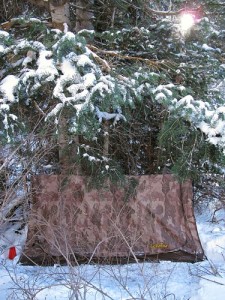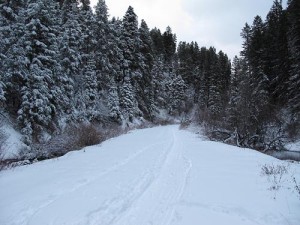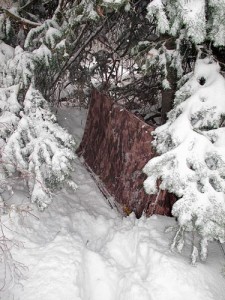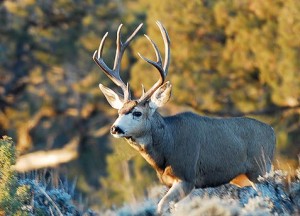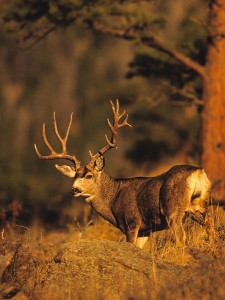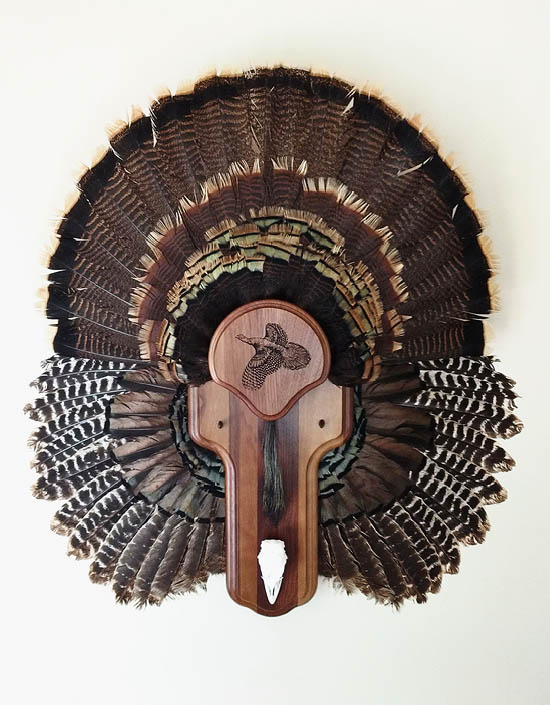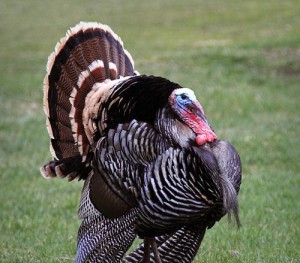
Trouble with Turkeys: My 1st Turkey Hunt
I never thought much about turkeys. I love bowhunting more than anything, but it was my wife Esther who took an active interest in hunting turkeys. In spring we drew turkey tags for Southern Utah where we’d come across plenty of birds in the past. Getting tags was easy enough, but that’s where easy ended.
First off, we decided to do it with a bow. I don’t do guns—I am a bow-snob…I mean purist—so now we were hunting unfamiliar prey with light tackle.
Second, Esther couldn’t get any time off work. Her schedule is a consummate nightmare, but somehow she was able to secure a single weekend at the end of the April. Now this proved to be a problem because the turkeys we ultimately hunted were already people- and call- wary. Can you say sloppy seconds?
Thirdly, the weather report called for heavy thundershowers and snow. What choice did we have? We went for it anyway.
We left late Friday night and already it was raining. Four hours later we set up camp in the back of the truck and went to bed. The morning was cool and lovely. We ventured across a small river and up the mountain. I decided to make a video of our ordeal, so Esther carried a bow and I carried a camera. I would be the caller for the first couple days, and after she got a shot it would be my turn.
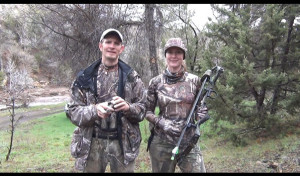
We hiked and called for a few hours, but got no response. A while later, we heard a turkey gobble out of the blue, so we set up a decoy, dropped back, and began a calling sequence. The turkey ignored us and so we kept hiking.
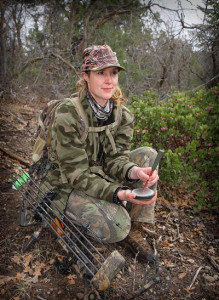
Later that afternoon, some thick, black clouds rolled in. As we were making our way back down the mountain, a gobbler fired up fairly close by. We holed up under some junipers to devise a strategy, and that’s when the rain started. We pulled out our raingear and pretty soon it was a downpour. At some point I realized we were on the wrong side of the river, and if the rain continued we might get trapped on the mountain. So we bagged the hunt and made a run for it.

By the time we reached the truck the rain had turned to heavy snow. The snow let up later in the afternoon and so we ran back up to where we heard the gobblers. But they were gone. For the rest of the evening we hiked all over looking for tracks in the new snow, but found none. The turkeys had flown the coop!
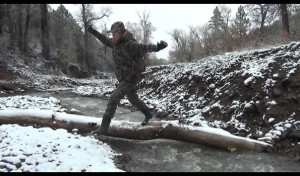
The next morning we woke to a full-on blizzard. Around 10 a.m. it subsided, so once again we crossed the river and headed up the mountain. We hiked from four inches to six inches of snow. We covered an immense amount of ground, but heard no gobbles and found no tracks. The turkeys were gone.
It seemed to me that the only direction they could have gone is downhill, so we packed up the truck and headed to the bottom of the mountain.
It rained most of the day so we spent several hours driving the low-elevation dirt roads and scanning the hillsides for black blobs in the snow. We found none.
In the late afternoon we decided to find a place to camp. I remembered a dirt road that gave access to the low-elevation drainage. Basically, the steep dirt road drops into a bowl before turning back up the mountain. Well, half-way to the bottom, the truck started sliding sideways and I struggled to maintain control. We got to the bottom okay, but now we were really stuck. We slopped to a flat spot to camp, then, with a break in the storm, hiked up the mountain to see where we’d be spending the last day of the hunt.
Things began looking up.
Almost a mile up the muddy mountain, we heard a gobble. With a couple hours of light left, we rushed in, threw out the decoy, and made some calls. There were three gobblers struttin’ around us, but it was way too thick for a shot. I kept dropping back and making hen calls, but they just kept circling us nervously and gobbling every few minutes.
We pulled the decoy and repositioned to a better clearing, but they still wouldn’t come in. We pulled the decoy again and rushed toward them. We were getting close, and so was nighttime. As we sat there trying to figure out where to plant the decoy, some big red heads came bobbing through the sagebrush. The toms were about to pass right in front of us at only twenty yards! Esther nocked an arrow, and when the turks went behind a juniper bush I whisper-yelled, “30 yards!” When they broke into the open, Esther let an arrow fly…and missed! The arrow sailed right behind the first turkey and the second turkey jumped straight into the air. Somewhat alarmed, they all trotted out of sight.
It’s funny how thin the line is between failure and success. After two hard days of hunting, we suddenly had turkeys all around us. Although Esther missed, we were just excited to finally be into the turkeys!
On Sunday we got up early and hiked to where we left the turkeys. We were excited, and I even carried a bow this time. Sure enough, we were greeted by gobbles. Several times we set up the decoy and made calls. The toms responded diligently, but wouldn’t come in. Instead they continued up the mountain and we followed.
Now this is where things get real bad; where Nate and Nature have a serious falling out.
With plenty of new snow, it was easy to follow their tracks. We spotted the turkeys a hundred yards ahead of us. I quickly set up a decoy and dropped back to call. Just as I started calling, a small herd of elk came running through the oak brush. The elk had caught our scent and ran right through the turkeys, nearly trampling them! The turkeys spooked farther up the mountain and we followed.
We caught up to the turkeys moving ahead of us in some boulders and brush. Squatting low to the ground, I trotted up and planted the decoy again. No sooner had I started calling, some coyotes suddenly lit up howling like crazy a short distance behind us. The toms made one last gobble, some other turkeys across the canyon gobbled back, and then everyone shut up. Those were the last gobbles we heard.
Esther and I followed the tracks way up the mountain into the deep snow, but they were moving too fast. Eventually the tracks led out of the huge valley, crossed a saddle, and disappeared. Stupid coyotes!
Frustrated, we turned back. While on top of the mountain, Esther decided to call into work and let her boss know we were stuck in the mud and may not get out by tomorrow. Her boss wasn’t there, but the nice fellow who answered the phone informed her that her 23-year old work-friend had crashed his motorcycle and died over the weekend. Now we were super-bummed for the rest of the day.
With the day slipping away, we had no choice but to make our way back to where we started. Who knows; maybe we could find some new turkeys.
And we did! Half-way to the bottom of the canyon I spotted a hen walking in the sagebrush. I made some calls and some new gobblers fired up. I snuck out to the open and plugged the decoy in the mud and snuck back. I could barely make out two large, strutting males wandering back and forth in the trees ahead.
We started calling and this time a herd of nine deer came bounding out below us. Now, these deer were hell-bent on going uphill, and did so by running right through the turkeys. All the commotion spooked the turkeys off and again it was silent. You gotta be kidding me! First elk, then coyotes, and now deer!
With no other choice, we followed the toms into the dark timber. The snow had melted in the lower elevations, so following tracks was no longer possible. However, a short while later we got them gobbling again. The problem was they refused to come in. We called for more than an hour with no luck.
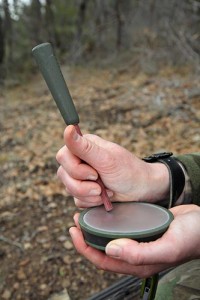
Frustrated, I decided to make a move. I told Esther to hang back. I’d sneak above them, and if they spooked, they might run back towards her.
It didn’t work. Instead, one of them busted me and all three toms slipped away down the mountain. I went back and got Esther. With only a couple hours of daylight, we made one more setup at the bottom of the canyon.
After half an hour of futile calling, I couldn’t take it anymore. I wasn’t going to just sit there and watch it get dark on my hunt. I told Esther I was going to enter the dark timber and sneak around for the last hour of light. She would stay in the ravine with the decoy and continue calling occasionally.
I was hiking up the steep, timbered mountain slope when out of the blue I heard something: “Cluck—-cluck—–cluck.” Well, this was new to me! I pulled an arrow. Sure enough, 40 yards below me, a huge chicken—I mean turkey—came sneaking and clucking along, all alone and completely oblivious to my presence. As it rounded a tree I let my arrow fly.
The arrow hit the giant black bird perfectly broadside and dead-center. The tom’s wings flapped wildly as it sprinted out of sight with my orange fletched arrow sticking straight out of its side. I was super excited as I dropped down to see my trophy…which was gone.
I found a couple clipped feathers and some torn up dirt, even a speck of blood or two. I followed in the direction the stupid bird ran, found another feather, and then lost the trail. I started walking circles. I called Esther on the radio to come help. She showed up and we search up and down and all over. The turkey was gone; run off to who-knows-where with my arrow. The problem with turkeys is two-fold: they don’t leave a blood trail, and they can sure take an arrow!
We continued our search by headlamp, but with no trail to follow, there was no choice but to give up. I was so deflated as I walked back to the truck. Few words were spoken.
The next morning we somehow slogged the truck out of the mud and drove home with nary a feathered foe for food.
Later study proved the turkey’s can take an arrow better than most animals. Basically their stiff wings, when folded against their bodies, creates a sheet of armor, like a stack of zip-ties. This armor will slow, or even stop an arrow, before it penetrates anything vital. In most cases it eventually kills the bird, but only after a lengthy sprint. A head/neck shot is really your best option.
The story ends here. But it also begins here. Next year you’ll find me and Esther in the same area, earlier in the season God-willing, with both heavier arrows and more experience in our quivers.
When facing nature one-on-one, the mountain and its infinite variables often wins. But this particular mountain still owes me a turkey, and I’ll never give up until I get one.
Happy Thanksgiving!


